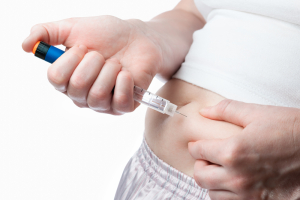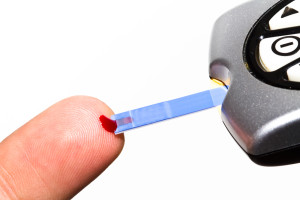Introduction
Patients with type 2 diabetes (Type 2 DM) are usually older than 30 years of age.
That’s why they are called “mature onset diabetes” or “adult onset diabetes”. For several decades a patient may “incubate” diabetes and have one or more of the diabetes risk factors, such as high blood pressure, obesity, high cholesterol or high triglycerides, but have normal blood sugars.
Physicians have followed patients like this for several decades in the well known Framingham Heart Study and found that a high percentage of them do come down with diabetes type 2 later in life. In the past this time of incubation was termed “pre-diabetes”. Now we call it “syndrome of insulin resistance” or “metabolic syndrome”. Diabetes belongs to the group of diseases that are associated with chronic inflammation in the body.
In contrast to type 1 diabetes, ketoacidosis is rare in patients with type 2 diabetes. Type 2 diabetes is often associated with other endocrinological diseases such as Cushing’s syndrome (an adrenal gland hyperactivity) or acromegaly (increased growth hormone production). In these diseases other hormones are tilting the hormone balance by counteracting insulin thus leading to a relative shortfall of insulin, which is another cause for type 2 diabetes. There is confusion among scientists regarding possible genetic reasons for type 2 diabetes. There might be various genetic loci that need to be triggered by the environment or by weight gain. The syndrome of insulin resistance has shown some connections between hypertension, obesity and type 2 diabetes and Ref. 1 suggests that the common denominator might be the production of amylin, which is deposited around the beta cells of the pancreas in late type 2 diabetes patients. Amylin can also be found in high percentages of patients who died from complications with hypertension or type 2 diabetes. However, the exact meaning of these findings is not clear.
Type 2 diabetes symptoms
Most of the time type 2 diabetes is found by diabetes screening in the doctor’s office and through lab tests the doctor has ordered. A less common presentation is, if a patient suddenly presents in the Emergency Room of a hospital in an unconscious state.
Doctors call this a “hyperglycemic hyperosmolar nonketotic coma”. These patients are often elderly ( 70 years of age or more), possibly unaware of their diabetes, dehydrated and have an infection such as a lobar pneumonia.
Blood tests for diabetes often show that ketones are negative, but blood sugar readings are extremely high coupled with a severe metabolic acidosis and possibly signs of kidney failure. The mortality rate in this setting is often 50% or more even with the best treatment.
Other symptom presentations are due to hyperglycemia as discussed under type 1 diabetes (follow diabetes link below). This consists of frequent urination, thirst and dehydration coupled with weight loss. Often these symptoms are overlooked and the first symptoms might be due to the complications of diabetes as follows.
Diabetes tests
The standard test used to be the fasting blood sugar and the 2 hour post prandial blood sugar (post prandial means “after a meal”). This is now largely replaced by the hemoglobin A1C blood test and also by doing and recording home gucosometer readings frequently.
Hemoglobin A1C
________________________________________________________
Hemoglobin A1C is a blood test measuring the sugar content of red blood cells. It is a very reliable predictor for how much damage is done by the diabetes through the process of incorporating sugar into the protein layer of the body’s cells. Red blood cells live about 100 days between production in the bone marrow and absorption in the spleen. This is why the hemoglobin A1C level will give an average of the blood sugar control for the past 1 to 3 months. With chronically poor hemoglobin A1C values there will be micro damage in the filter organs in the kidney, called glomeruli. This leads to a poor kidney function. For instance, after 5 years of poorly controlled type 2 diabetes a significant number of diabetics will show positive albumen tests of their urine as a sign for leakage of this blood component and we know that these patients have now a reduced glomerular filtration rate, which can be confirmed with special kidney function tests. Within 10 years of poorly controlled diabetes a high percentage of patients either need dialysis or a kidney transplant to replace their damaged kidneys.
________________________________________________________
Fructosamine level
A newer test to supplement the hemoglobin A1C test is the fructosamine level. This is a blood test, which measures how well the blood sugar has been controlled in the last 1 to 3 weeks (rather than 3 months) and is based on a chemical reaction between the blood sugar and the plasma protein. This test might be useful as a tool to the physician in the beginning when time is of essence in seeing a positive effect of the treatment.
Treatment of Diabetes
Treatment of DM is done following a diabetic diet and using insulin or using diabetic drugs. This is dealt with under separate links.
References:
1. MT Kailasam et al. J Hypertens 2000 Nov 18(11): 1611-1620.
2. G Chinetti et al. Inflamm Res 2000 Oct 49(10): 497-505.
3. St. Paul’s 46th Annual Cont. Med. Educ. Course for Prim. Phys., Nov. 14-17, 2000. Dr. David Thompson, Div. of Endocr., Vancouver Hosp. and UBC.
4. B J Goldstein Int J Int Pract 2000 Jun 54(5): 333- 337.
5. M Maghnie et al. N Engl J Med 2000 Oct 5;343(14): 998-1007.
6. E Albertazzi et al. J Am Soc Nephrol 2000 Jun 11(6):1033-1043.
7. M Funk et al. American Journal of Emergency Medicine Vol.19,No.6, Oct.2001, W. B. Saunders Company
8. Ferri: Ferri’s Clinical Advisor: Instant Diagnosis and Treatment, 2004 ed., Copyright © 2004 Mosby, Inc.
9. Rakel: Conn’s Current Therapy 2004, 56th ed., Copyright © 2004 Elsevier








